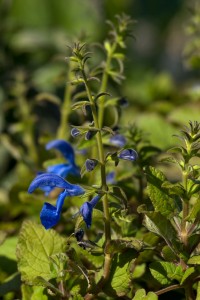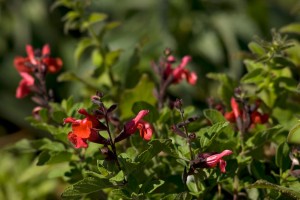Gardening with Salvia
Posted in Gardening Tips, Shop/Book Reviews on June 4 2009, by Plant Talk
 |
Richard Pickett is Director of Retail Operations. |
 Salvia has been seducing gardeners for centuries. Roman scientist and historian Pliny the Elder was the first to use the Latin name Salvia. The name derives from salvare, to heal and save, and salvus, meaning uninjured or whole. But for today’s avid gardeners salvias, or sages as they are commonly known, are not only used for their culinary and medicinal properties but for their vibrant flowers and easy cultivation in almost any climate.
Salvia has been seducing gardeners for centuries. Roman scientist and historian Pliny the Elder was the first to use the Latin name Salvia. The name derives from salvare, to heal and save, and salvus, meaning uninjured or whole. But for today’s avid gardeners salvias, or sages as they are commonly known, are not only used for their culinary and medicinal properties but for their vibrant flowers and easy cultivation in almost any climate.
At the Botanical Garden, you can see several species of Salvia by visiting the Perennial Garden, the Rock Garden, and the Home Gardening Center. The Family Garden has planted a number of varieties as well, including one with dark violet flowers, Salvia ‘Indigo Spires’, and bog sage, Salvia ‘Ulginosa’. And, of course, Martha Stewart used plenty of Salvia in her recent redesign of the historic Herb Garden. You can even download a site plan of Martha Stewart’s Culinary Herb Garden, which will be a feature of The Edible Garden celebration this summer.
 If you’re inspired to include salvias in your own garden, be it urban or suburban, you’ll find a wide variety of both perennial and annual salvias in Shop in the Garden, from Salvia officinalis, culinary sage, to Salvia nemorosa, perennial meadow sage, and the unusual annual, black-flowered Salvia discolor.
If you’re inspired to include salvias in your own garden, be it urban or suburban, you’ll find a wide variety of both perennial and annual salvias in Shop in the Garden, from Salvia officinalis, culinary sage, to Salvia nemorosa, perennial meadow sage, and the unusual annual, black-flowered Salvia discolor.
The genus Salvia has arguably the truest blues and brightest reds of any group of plants and their applications are endless—borders, baskets, herb gardens, and patio pots to name a few. There is room in any garden, terrace, or patio for a Salvia or two. They are deer-resistant, relatively drought tolerant, and attractive to hummingbirds and butterflies. What more could a gardener ask?

